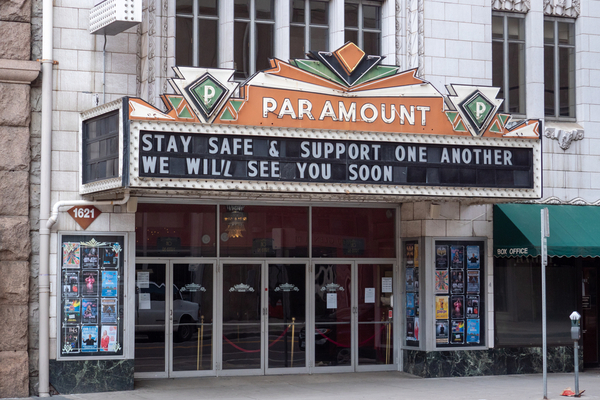Like many businesses, movie theaters have been hit hard by COVID-19. After closing their doors across the country when the coronavirus pandemic closed down most of the country in March, some chains have recently reopened or are opening their doors now. Understandably, many people have reservations about sitting in an enclosed space with strangers. In the coronavirus age, there’s a lot more to consider than what film to watch and what size popcorn to order.
Health magazine reports that AMC Theatres reopened its doors on August 20, and two other big chains, Cinemark and Regal, have also opened theaters in selected cities. It’s great news for film buffs who’ve been missing their big screen fix, but from a health and safety perspective, should we stick to at-home movie nights for a while longer?
First, it’s worth noting that the Centers for Disease Control and Prevention (CDC) includes going to a movie theater on its list of higher-risk activities. This is because a movie theater brings people indoors and in close proximity for extended periods of time.
In an interview with Health, Anne Rimoin, PhD, MPH, professor of epidemiology at UCLA Fielding School of Public Health, put it this way, “the virus is transmitted through droplets when we talk, laugh, and breathe. A movie theater is a place where you sit with a room full of strangers eating and drinking for two to three hours with sub-optimal ventilation,” explains Rimoin. “It’s exactly the type of scenario we need to be avoiding to reduce opportunity for the virus to spread.”
The possibility of transmission within a movie theater is similar to that inside restaurants, adds Carol A. Winner, MPH, founder of the Give Space personal distancing movement in 2017. “Although people are talking less in the theater, the mask may come off, and then the danger comes when they laugh, cough, sneeze, and then may try to talk to their friend who is five feet away.”
All the major movie theater chains that are reopening venues have announced the measures they’ll take to keep customers safe. It’s important to note that each chain has its own policy regarding mask-wearing. AMC and Cinemark Theatres, for example, require customers to wear face masks at all times, except when they are eating or drinking. Other chains, such as Regal, require masks be worn in lobbies, hallways, and restrooms but not in the theater itself.
Social distancing policies also vary by theater and location, but all chains are mandating some level of reduced theater capacity and are keeping seats empty between people or groups of people who have arrived together. Theater operators are doing more intense cleaning of their facilities. And many theaters are not taking cash or are encouraging contactless payment methods for tickets and concessions.
While all of these measures can help prevent the spread of the coronavirus, it can’t stop it altogether. In many cases, it’s hard to know if your fellow theatergoers are following all the rules. Winner points out that it’s extremely difficult for staff to enforce mask-wearing guidelines in a dark movie theater, for example.
If you do go to a movie theater, Rimoin advises choosing a theater that is significantly limiting occupancy, is very spacious, and requires masks at all times. “I would not remove your mask to eat or drink and would avoid using the restroom as well,” she advises.
Winner suggests more precautions. “Social distance from the moment you hit the door,” she says. “Use your hand sanitizer, particularly after you settle into your seat. To avoid any vendor or surface transmission, you may want to refrain from eating or drinking in the theater.”
Being cautious doesn’t end when you leave the theater. The CDC recommends that anyone who took part in a higher-risk activity like going to the movies spend the next 14 days staying home as much as possible, avoiding contact with people who have underlying conditions that put them at risk for COVID-19, and getting tested for the virus.
For all of the above reasons, Rimoin doesn’t recommend going to a movie theater right now. “There is no zero-risk scenario going to a theater, and we should be doing everything we can to either bring down or keep down rates of transmission,” says Rimoin.
Winner agrees. “The jury is still out, but in consideration of these variables and the crowded lobbies and bathrooms, movie theaters may become super spreader events,” she warns. “It’s safer to cuddle up at home with Netflix or Hulu and a big bowl of popcorn than head out to the movie theater. There are simply too many variables that put us at risk.”
—
Photo Credit: Myra Thompson / Shutterstock.com
